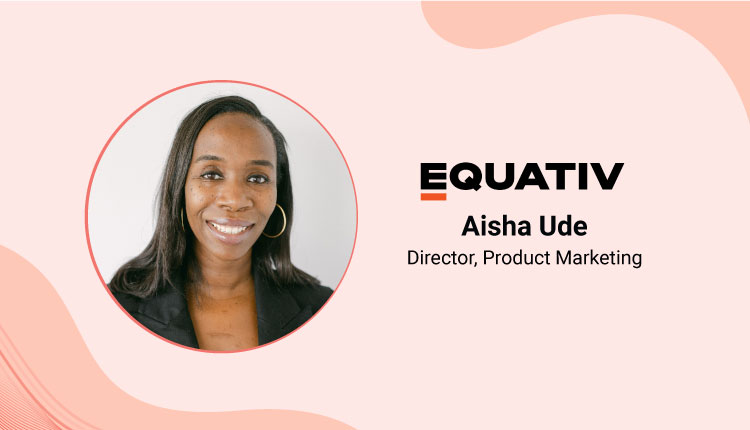Aisha Ude, Director, Product Marketing at Equativ shares a few observations on media transparency and the evolution of adtech in this short Q&A:
Hi Aisha, tell us about yourself and your role at Equativ.
As Director of Product Marketing, Demand, I lead the team responsible for positioning Equativ’s buy-side products. This includes our media solutions, marketplace, CTV offering, and Equativ Buyer Connect – our self-serve curation platform. Our objective is to drive market adoption for our products among advertisers and agencies.
While I love this exciting, dynamic adtech world, it’s one I stumbled into accidentally. Following my internship at AOL – in those simple days when there were only three portals – I kicked off my career at MySpace, and I’ve been evolving with the industry ever since.
We’d love to hear more about Equativ’s platform and how it’s evolved over the years.
Equativ Buyer Connect was launched in 2020, with recent enhancements to the platform making it even more advanced and aligned with market needs. However, its central purpose—to give buyers greater control and bring them closer to publishers—hasn’t changed.
Our aim is to simplify audience targeting by helping remove complexity from bloated supply chains. The platform gives buyers control and transparency, so they can build custom private marketplaces that combine data, formats, and measurement with premium brand-safe inventory from media owners in Equativ’s marketplace. Packaging multiple deals into a single deal ID allows them to achieve more efficient audience targeting at the scale they need.
Not surprisingly, we’ve been focusing on future-proofing our curation platform so buyers can confidently navigate the post-cookie era. We’ve enhanced it in two key areas. Firstly, around privacy-first identity and targeting solutions so buyers can leverage the myriad of options , from contextual-driven approaches to activating first-party data in clean rooms through our Habu partnership. Secondly, when it comes to identity, rather than limiting buyers, we’re taking an agnostic approach to alternative ID solutions. This ensures they have a persistent view of their audiences by using signals from multiple alternative IDs to deliver more relevant, personalized messaging across any DSP and measure key performance metrics across the marketplace.
How are media buying solutions evolving today and changing the game for end users?
We’re seeing curation facilitate a return to the past by reestablishing and rebuilding buyer-seller relationships. By allowing buyers to create marketplaces with their preferred publishers, curation platforms give them greater control of the supply chain and purchase through more direct paths to inventory. Simplifying the process, including tracking and spend reconciliation, delivers efficiencies and transparency, while restoring trust and harmony between buyers and sellers.
Marketing Technology News: MarTech Interview with Brad Gillespie, GM @ Cvent Consulting
What are some of the biggest hiccups to media transparency in today’s market?
The major one is the cluttered and fragmented supply chain. This has led to a loss of transparency andchallenges in delivering ROI. Thankfully, curation is proving to be the answer. By untangling the complexity, curation is ushering in greater supply chain transparency, allowing more efficient deal transactions across multiple publishers, converting more spend into working media, and complementing open auctions with curated deals. It’s heralding more positivity when it comes to advertising.
What would you say about the future of adtech and the impact of AI on the overall adtech space?
Undeniably, its impact will be profound. It will transform adtech – for the better. And while there’s so much more to come, AI is already being incorporated within the programmatic space and making a difference.
Today, advertisers are leveraging data and AI technologies to deliver more personalized, targeted, impactful advertising, which will become increasingly important when cookie-driven targeting dies.
It’s powering advanced analytics and predictive modeling, giving buyers deeper insights into market trends, consumer behaviors, and campaign performance. This lets them make quicker, more informed, and strategic decisions on campaign and ad spend optimization.
Five adtech takeaways you’d leave us with before we wrap up?
Here are my five which are very relevant today:
- Choose your partners wisely. Work with those who offer the control, transparency, and flexibility you need to simplify programmatic buying and execute your strategies effectively and efficiently. But don’t forget the importance of service. This can make a big difference and enhance your performance.
- CTV supports all your campaign goals. TV has traditionally been a medium for building brand awareness. While CTV also delivers this, it’s increasingly being used as a lower-funnel performance-driven content platform. In allowing granular data-led targeting, it’s generating measurable web visits, conversions, and, critically, revenue.
- Take advantage of the cookie phase-out delay. While postponing third-party cookie deprecation until 2025 may not have come as a surprise, don’t waste the gift of extra time. Use it to adopt a multi-pronged approach by testing alternative privacy-first solutions and use cases. And augment this by exploring how you can take advantage of the new KPIs coming to the fore, such as attention targeting and measurement.
- Realize the potential of your first-party data. Better insights, targeting, and personalization are just three reasons why first-party data is critical in a cookieless world. So take advantage of what you have by understanding how to activate and maximize its value going forward.
- Adopt a progressive media buying approach. Make sure your brand’s purpose aligns with your media buying. Today, diversity, sustainability, and ethical practices shape how brands and consumers think. So take a proactive stance by ensuring your values mirror your media choices.
Marketing Technology News: Next-Gen Marketing Automation Platforms: Latest Advancements

Equativ is the new single name for Smart Adserver, DynAdmic and LiquidM — three proven innovators in advertising technology.
Aisha is a seasoned product marketer with over 15 years of experience. As Director of Product Marketing, Demand at Equativ, she is responsible for driving market adoption of Equativ’s buy-side products – including the company’s media solutions, marketplace, CTV offering, and its self-serve curation platform, Equativ Buyer Connect. Aisha has previously held a similar role at Xandr where she honed her skills in simplifying complex challenges and transforming them into clear, actionable strategies. Aisha’s expertise spans various marketing disciplines, enabling her to seamlessly bridge the gap between strategy and execution for successful product launches.











